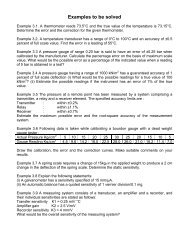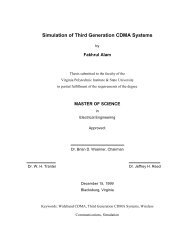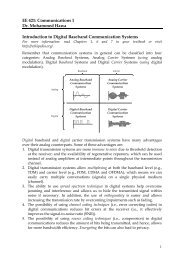Measurement Lab. Resistance Temperature Detector (RTD) - FET
Measurement Lab. Resistance Temperature Detector (RTD) - FET
Measurement Lab. Resistance Temperature Detector (RTD) - FET
You also want an ePaper? Increase the reach of your titles
YUMPU automatically turns print PDFs into web optimized ePapers that Google loves.
Nominal <strong>Resistance</strong>Nominal resistance is the pre-specified resistance value at a given temperature. Most standards,including IEC-751, use zero as their reference point because it is easy to reproduce. TheInternational Electrotechnical Commission (IEC) specifies the standard based on 100.00 Ohms at0 o C, but other nominal resistances are quite common. Among the advantages that thin filmtechnology has brought to the industry are small, economical elements with nominal resistancesof 500, 1000, and even 2000Ohms.For some types of <strong>RTD</strong>'s, there are also equations that give you the temperature from a givenresistance. This information has made it possible for instrument manufacturers to providestandard readout and control devices that are compatible with some of the more widely acceptedtypes of <strong>RTD</strong>'s.The heart of a <strong>RTD</strong> sensor is an element which is generally made of wire wond on a ceramiccore. The element is encased in a metal sheath probe which provides good heat transfer as wellas protection against moisture. The sheath is generally mades of stainless steel or some specialmetal alloy which can withstand high temperaures. <strong>RTD</strong> elements are usually made of platinum.Some <strong>RTD</strong>s have been made using nickel, copper ,iron or tungsten. The elemente`s resistance,usually calibrated at zero degrees C, will increase as the temperature rises. The <strong>RTD</strong> resistanceincreases by a factor of nearly two. If the element is placed in a wheatstone bridge circuit asshown in figure (2), the bridge would exhibit an imbalance as the element`s resistance increasedwith temperature.
















